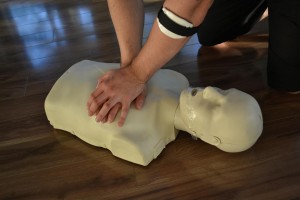What is so important about CPR?
If you work in a healthcare, whether in or out of a clinical set up, cardiopulmonary resuscitation skills are a must. Being trained in CPR means that you are able to recognize and manage cardiovascular and respiratory emergencies should they occur. Cardiac arrest is a very serious cardiovascular emergency where the heart stops. If the heart cannot pump oxygenated blood to the rest of the body, especially the brain, the major organs start to fail which can lead to death. CPR can help prevent that by manually pumping the heart with chest compressions.
For lay people who don’t work in healthcare, being trained in CPR is still an important life skill. Because you can never tell when an emergency can happen, it pays to be trained in basic lifesaving skills. You never know when a loved one, friend, or even a stranger on the street can suddenly experience a heart attack. If you know how to adequately give CPR, you can save someone’s life. The minutes following cardiac arrest are the most important. It can take long for the EMS to get there and start CPR so as a trained rescuer, you can do your part.
What kind of training will I receive?

CPR training is divided into two categories, Basic Life Support and Advanced Life Support. Both categories have several programs under them for the general public and people in healthcare. There are three programs under BLS, one for the general public, and two for HCPs. BLS programs are self-explanatory – they teach basic CPR skills in chest compressions, rescue breaths, and defibrillation. BLS is focused more on getting the victim stabilized or at least to return spontaneous circulation of blood in the body.
- Heartsaver CPR and AED – This basic program is for the general public. It’s four hours long, focused in basic 1-person CPR management and first aid. This program doesn’t have a re-certification class that accompanies it. There is an optional skills test given at the end of the program for students who want to get certified as a rescuer.
- Heartsaver CPR and AED (C) – This basic program is for HCPs. It tailors the lessons in the other Heartsaver class for HCPs, with the overall curriculum remaining the same. There is no re-certification class with this program as well. To get certified, students need to pass the written and skills test at the end of training. These post-tests are mandatory. This program runs longer for 4.5 hours.
- Basic Life Support – BLS is another HCP program that runs for 4.5 hours. It teaches 1-person and 2-person CPR management and first aid. It also teaches the 2010 BLS guidelines from the American Heart Association. Re-certification is four hours long. Post-tests are mandatory as well.
ALS programs are much more complex, covering post-cardiac arrest care that starts with the EMS and lasts until the victim is brought to the hospital. There are two kinds of ALS programs, one for adult victims – Advanced Cardiac Life Support – and one for pediatric victims –Pediatric Advanced Life Support . Because ALS is focused on management in a clinical setting, only HCPs can sign up for ALS training. Both ALS programs have the same structure, they focus on the crash cart and the medication and equipment it contains, beyond the basic skills training. ACLS training is 16 hours long and PALS is 14 hours long; both programs take two days to complete. Re-certification for both programs is 5-6 hours and 6-8 hours respectively.
Certificates are only valid for two years. They can be renewed through a re-certification class.